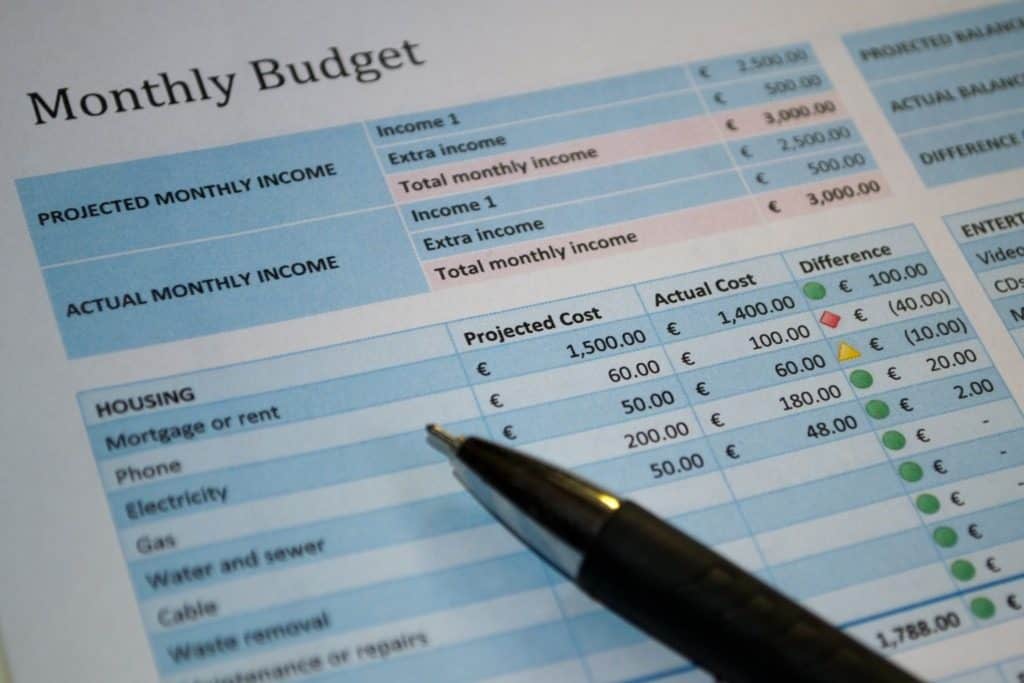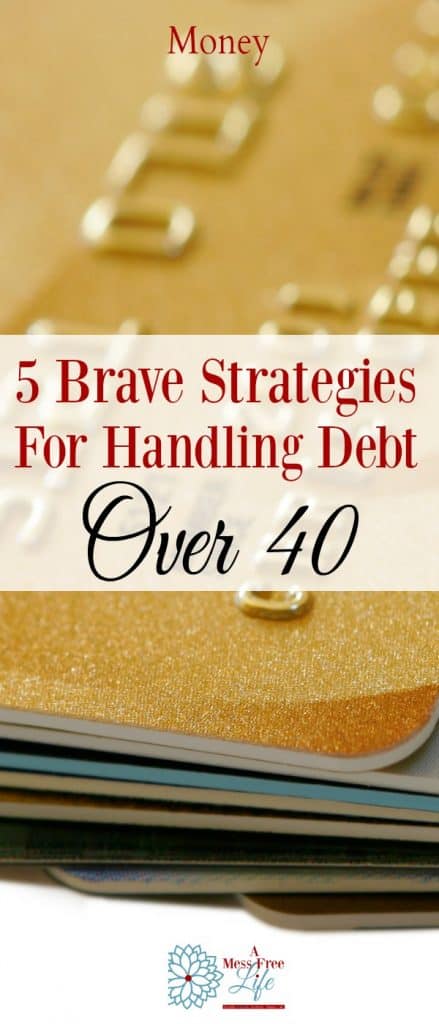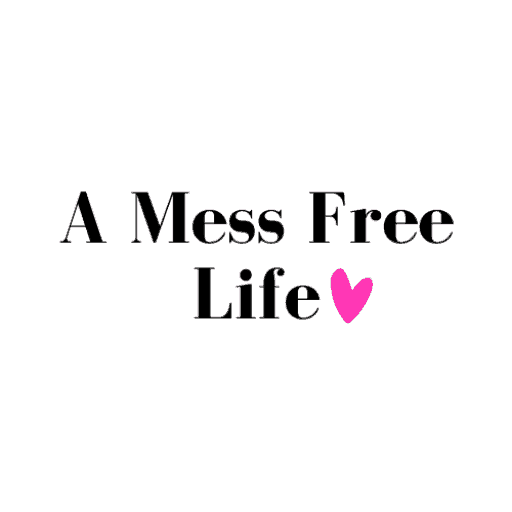A Mess Free Life may collect a share of sales or other compensation from the links on this page.
Over 40 and dealing with overwhelming debt can be downright paralyzing.
Where do you begin? What do you pay first? And how do you manage to keep up so you don’t get even further behind?
I remember when I had overwhelming debt. I was constantly stressed out and worried about my financial future.
When I was faced with foreclosure due to the debt it also threw me into a tailspin about the possibility of being homeless.
It wasn’t fun AT ALL.
In fact, it was the most horrible time of my life.
At the time of my crushing and overwhelming debt I was 40 years old with a teenager in college and two parents that were semi-dependant on me both financially and otherwise.
I know many of you are in the exact same boat and I want to help you today to find a reasonable and doable solution to getting out from under overwhelming debt.
Table of Contents
5 EFFECTIVE WAYS TO DEAL WITH OVERWHELMING DEBT IN YOUR 40’S
If you’re over 40 and you’re staring at debt from years of overspending I’m here to show you a simple path to dealing and eliminating it.
Now is the time to start.
If you don’t start doing something about it, it will only get worse.
Dealing with overwhelming debt can lead to stress, sleepless nights, difficulty in relationships, and even difficulty at work. Finances are a leading cause of divorce and breakdown in the trust you’ve built in your marriage.
Even if your marriage can handle dealing with debt, the stress (and fights) can cause stress for your kids.
The stress and lack of sleep can also lead to health issues.
Colds and flu are easier to catch, muscles are more susceptible to aches and pains, and it can even take a toll on your heart and brain health. Dealing with all of these issues in addition to the stress itself can lead to a lower performance rate at work which can keep you from advancing and making more money.
Or worse, getting fired.
Even if you haven’t lifted the burden of debt yet, knowing that you have a plan and that you’re working the plan can reduce stress and tension, allowing you to be more productive in your efforts. Having a plan means you have hope for a better future and you’re working towards that goal, which will lift your spirits.
So where do you start?
Well, before you can do anything else, the first thing you need to do is have a complete understanding of how much debt you have. Absolutely everything. No matter how big or how small, you need to get it on the list so you can see what you’re dealing with.
Start by writing down everything you owe. Even if you’re making monthly payments and you’re not behind on it, write it down as part of your debt.
Include any past due and current bills, car payments, loans, credit cards, even your mortgage. You need to get the big picture of where your finances stand.
After you’ve written this all down, organize it.
Start with your regular monthly payments like utilities, insurance, mortgage, and car payments. Add your credit cards and loans; include the monthly amount due in your monthly column, the past due amount in a second column, and the total amount in a third column.
These numbers will start to look a little scary as you write them down, but knowing the beast you have to manage will help you to face it head-on.
Use a spreadsheet if that helps or a legal pad with columns for “current”, “past due”, and “total”. Total each column individually then add them all together. Regardless of how big or how small the number is, you can now start to manage it.
Please don’t skip this step because you “can’t face it” or “don’t want to know”.
The reality is you must figure this out and face the total amount. It’s the only way you can accurately see all the progress you’re going to make in eliminating the debt.
Plus, you don’t do yourself any favors by keeping yourself in the dark. The truth lies on that piece of paper and in the numbers.
I know it’s scary but you can do it!
DEALING WITH OVERWHELMING DEBT IN YOUR 40’S
Now that you have all your numbers documented and you know where you stand it’s time to start applying the tips that will get you out of debt.
BUDGET
If you don’t already have one, you need to start budgeting so you can figure out where all your money is going and where you can start cutting back so you can pay down your debt. Consider cutting cable, reducing your cellphone bill, and eliminating dinners out until your debt is under control.
Use this money to make a quick dent in your debt by paying off as many of the smaller bills as possible first, leaving only the larger ones. Once the smaller accounts are paid off, don’t use them anymore so you don’t acquire more debt.
Better yet cut up those credit cards at once and start using cash.
Now you can start using that money to pay down larger debts.
This is the snowball method of paying off debt. For a full tutorial go here.
NEGOTIATE
The simplest solution to many of your credit card and loan debt is to try and negotiate a settlement.
Be aware, this sometimes means closing the account so only do this if you’re maxed out, know you won’t use the card again, and just want it off your shoulders. Or if the company has already closed your account and it’s getting ready to go to collections.
Most loan and credit card companies would rather get some of their money than nothing so they are often willing to negotiate with you for a portion of your total due. Interest fees, late payment fees, charge-off fees, and even some of the balance can be negotiated.
Companies are willing to do this if they can clearly see there’s no hope for them getting paid any other way so be sure to share your financial situation with them.
There are tax implications for doing this. Learn more about them here.
As a side note, the IRS is also usually willing to negotiate lower payments if you are behind on your taxes.
DEBT CONSOLIDATION
This means taking out one large loan in order to cover all the smaller debt you have and only owing one company. In most cases, your monthly payment is less than what you’re paying to all the individual companies, but your loan term may be longer. Your current credit rating can determine if this is even an option.
There are many cons to doing this. Learn all the ins and outs of debt consolidation here.
BORROW FROM RETIREMENT
If you have a retirement fund like a 401K, IRA, or another investment account, you can use some or all of that money to pay down debt. You will pay a fee for an early withdrawal and you’re sometimes required to pay it back, but the money can help you manage your immediate debt problem in the short-term so that you can start contributing to your retirement again.
I’m not a huge fan of this option as I feel there are other ways, like cutting your expenses drastically, to pay off debt. But it may be an option for you.
BANKRUPTCY
This should be an absolute, last-ditch effort to handle your debt because it will stay on your credit report for 7-10 years, making it harder, but not impossible to rebuild your finances. If you’re considering this, talk to a financial professional before making a decision and get some debt counseling. A Chapter 7 filing will discharge all of your debt and a Chapter 13 filing will allow you more time to pay off your debt. Either way, the collection calls will soon come to a halt.
If you’re considering this, talk to a financial professional before making a decision and get some debt counseling. A Chapter 7 filing will discharge all of your debt and a Chapter 13 filing will allow you more time to pay off your debt. Either way, the collection calls will soon come to a halt. Learn more about your Bankruptcy Options here.
CONCLUSION
Recovering from overwhelming debt isn’t impossible, but it will take a firm commitment to completely change your budget and expenses. It takes time and perseverance to get yourself back on track. Chose which solution might best suit your particular needs and then follow through with cutting up your credit cards and vowing never to get into debt again.
By creating and working a plan to pay it down, you can start to feel better about your circumstances.





